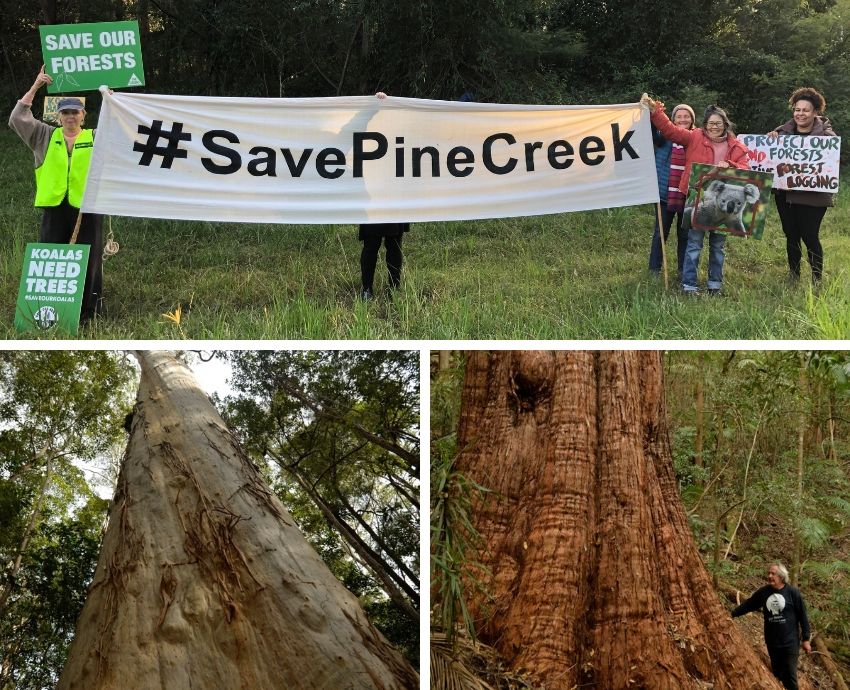
Local communities are fighting to stop New South Wales Forestry Corporation from logging an area critical for koala connectivity and habitat in Pine Creek State Forest on the NSW mid-north coast.
Forestry Corp plan to clear-fell swaths of Gumbaynggirr land, near Coffs Harbour. But many parts of Pine Creek State Forest are highly biodiverse, and numerous surveys have found the area to be prime habitat for endangered koalas.
The Pine Creek/Bongil Bongil National Park population is possibly the only stable population left in the Great Koala National Park (GKNP) proposal; it needs help now, as a National Parks and Wildlife Service survey confirmed late last year.
Friends of Pine Creek (FoPC) has organised public meetings to raise awareness of planned logging in the area and launched a campaign to stop logging in the forest.
The 648-hectare area slated for logging provides a critical wildlife corridor between Bongil Bongil National Park and Bindarri National Park. FoPC is calling for the protection of the “forest bridge” that allows koalas and other wildlife to move safely between the two parks.
FoPC facilitator Susan Harwood told Green Left that the forest bridge proposal, if implemented, would connect the two “intergenerationally significant areas” of Bongil Bongil National Park and Bindarri National Park.
The parks are listed as “Assets of Intergenerational Significance” under the National Parks and Wildlife Act, specifically because they provide habitat for koalas and other threatened species.
Harwood said the group lobbied the former Coalition government for three years. “We’ve written, or spoken to, the environment minister, the premier; we’ve written to the agricultural minister,” she said. “You name it, we’ve written letters to them.”
“The previous government’s responses have been basically, ‘Sorry, but [the forests] are too important for the timber industry’. We’re yet to get responses back from the current [Labor] government.”
NSW’s mid-north coast has the largest remaining koala population, although it is declining due to habitat being clear felled.
A 2020 NSW parliamentary inquiry found that koalas will be extinct by 2050 if no action is taken to stop habitat loss — the biggest threat to their survival.
A report commissioned by the World Wildlife Fund estimated that the 2019–20 bushfires killed more than 70% of koala populations across six sites in NSW.
But Pine Creek State Forest did not burn, along with nearby national parks. “That’s why Forestry Corp is moving into this area,” Harwood said. “Because there’s so many forests down south that were burnt.”
Forestry Corp has clear-felled thousands of hectares of koala habitat in the region, and breached the state’s already weak environmental protection laws several times.
Clear-felling also contributes to climate change, both by releasing stored carbon in trees and through the loss of carbon-sequestering forests.
“The trees in the forest are actually worth much more left in the forest to help mitigate climate change,” Harwood said. “Tearing them down and digging up the soil; that’s not going to help with climate change.”
For more than a decade, mid-north coast residents have fought for a GKNP to be created — the conversion of 175,000 hectares of state forest to national parks — to protect remaining koalas in the region.
However, Labor and the Coalition voted together last year to reject a Greens bill that would have established such a park.
Since then, NSW Labor has promised funding and the establishment of the GKNP, but environment minister Penny Sharpe has allowed logging to continue within the proposed GKNP boundaries.
The continued logging of ecologically important state and native forests is incompatible with protecting koalas.
Sharpe has essentially given Forestry Corp the green light to continue destroying native forests and environmentally significant state forests, like Pine Creek, which would devastate koala populations.
“We’re not the only forest that’s being hit,” Harwood said. “Lots of different forests in this region are being targeted by Forestry Corp.”
Forestry Corp plans to clear at least 16,000 hectares of native forest within the proposed GKNP over the next 12 months.
[Follow Friends of Pine Creek on Facebook for more information and campaign updates.]